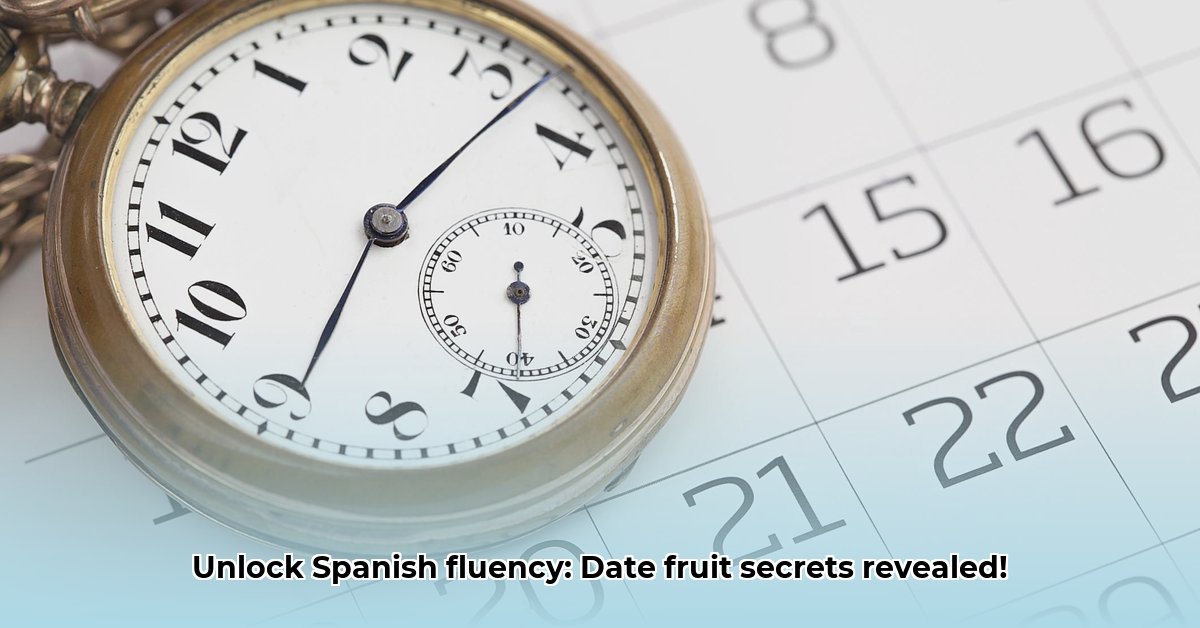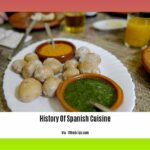Want to master how to talk about dates in Spanish? It’s not just one word! This guide reveals how to say “date fruit” like a native speaker, covering different ways depending on location and formality. With examples and practice exercises, you’ll impress locals with your Spanish skills. Let’s explore! For a helpful map of Spanish-speaking regions, check out this Spanish-speaking map.
Date Fruit in Spanish: Mastering Vocabulary and Culinary Nuances
Let’s explore the world of date fruit and how to discuss it with nuanced vocabulary. Whether shopping in Spain or impressing Spanish-speaking friends, understanding the terms for dates is key.
Everyday Conversations: The Casual “Dátil”
In everyday conversations, use “dátil” for date. It’s a friendly, casual way to mention these treats, understood almost everywhere. Simple and effective!
Pronunciation is key: “dah-teel.” Practice saying it until it sounds natural. Using “dátil” with friends, family, or ordering at a café is perfect.
Formal Settings: “Fruta/Fruto de Dátil”
In formal settings like restaurant menus, scientific papers, or formal conversations, “fruta de dátil” or “fruto de dátil” sound more sophisticated. “Fruta” means fruit in general, while “fruto” is botanical, suggesting the plant’s product. Either adds elegance.
Regional Variations: A Linguistic Trip
Like any language, Spanish has regional variations. How people talk about date fruit can differ from place to place. These aren’t wrong, just reflections of the language’s history.
| Region | Term(s) | Notes |
|---|---|---|
| Mexico | Dátil mexicano, dátiles | Emphasizes dates from Mexico. |
| Spain (some areas) | Palma de dátil, palma datilera | Refers to the date palm tree, not just the fruit. |
| Caribbean | Fruta/fruto de dátil, dátiles | Formal terms are common in writing and formal speech. |
| Colombia | Dátil, dátiles | Similar to general usage. |
| Argentina | Dátil, dátiles | Common usage, particularly in culinary contexts. |
This table shows examples; local customs might have other terms.
Plant vs. Fruit: Avoiding Confusion
You might hear words for the date palm tree, like “palma datilera” or “palmera de dátiles.” These describe the entire plant, not just the fruit. Understanding this prevents confusion. Context is crucial!
Putting Knowledge to the Test: Practice
Test your skills! Translate these sentences:
- I adore eating delicious dates. (A mí me encantan los dátiles deliciosos.)
- The date palm trees offer wonderful shade. (Las palmeras de dátiles dan una sombra maravillosa.)
- This recipe calls for fresh date fruit. (Esta receta necesita fruta/fruto de dátil frescos.)
Mastering a language takes time and practice.
Expanding Your Vocabulary: Beyond Date Fruit
Learning about date fruit is just a start. Many foods have regional names and variations in formality. Keep exploring for new ways to express yourself. Remember, choose the right word for the situation. With practice, you’ll speak Spanish like a local!
Mastering Date Fruit Terms in Different Spanish Dialects
Want to order dates in Spain? Knowing how to say it is key!
The Basic Word: Dátil
The most common word for a date is dátil (singular). For more than one, use dátiles. This is your go-to for most conversations.
Formal Options: Fruta/Fruto de Dátil
Sometimes, dátil feels informal. In scenarios like fancy restaurant menus or formal writing, opt for fruta de dátil (fruit of the date) or fruto de dátil (fruit of the date). Fruta is general, and fruto often implies a specific botanical fruit.
Regional Variations: Dialectal Differences
Spanish has regional variations. While dátil is widely understood, local expressions exist.
| Region | Alternatives | Notes |
|---|---|---|
| (Many Regions) | Palma datilera (date palm tree) | Sometimes used for the fruit, colloquially. |
| Canary Islands | Támara | A local term for dates. |
| Andalusia (Spain) | Alfajor (sometimes) | Refers to a date-filled pastry in some areas. |
Context is key.
Date Palm vs. Date Fruit: Avoiding Confusion
Talking about the tree or the fruit? Dátil refers to the fruit, so use palma datilera for the tree. Clarity is important, especially in agriculture or botany.
Practice
Test your knowledge!
- Translate: “I love eating sweet dates.” (Me encanta comer dátiles dulces.)
- Which is more appropriate for a formal recipe: dátil or fruta de dátil? (fruta de dátil)
Key Takeaways:
- Dátiles (plural) or dátil (singular) is the most common.
- Fruta de dátil or fruto de dátil is for formal contexts.
- Regional variations exist.
- Distinguish between terms for the fruit and the tree.
Proven Tactics for Using Date Fruit Terms – Community Insights
Want to sound like a local talking about dates? Let’s explore the world of dátiles!
The Basics: Dátil and Dátiles
“Date” in Spanish is dátil (singular) and dátiles (plural). Think “apple” (manzana) and “apples” (manzanas).
Pronunciation Pointers: Sounding Natural
Dátil is pronounced “DAH-teel.” Emphasize the first syllable. Dátiles is “DAH-tee-les.”
Common Phrases: Integrating Dátil into Conversations
- “Quiero comprar dátiles.” (I want to buy dates.)
- “¿Tienes dátiles?” (Do you have dates?)
- “Me encantan los dátiles con nueces.” (I love dates with nuts.)
Regional Influences: Adapting to Local Dialects
Spanish varies by region. While dátil is widely understood, some areas might have other terms or preferences. Being aware of regional differences shows respect and helps you connect with locals.
Cultural Significance: Dates in Spanish-Speaking Cultures
Dates are important in many Spanish-speaking cultures, often eaten during religious holidays like Ramadan. Offering dates to guests symbolizes hospitality.
Advanced Usage: Beyond the Basics
- “Palmera datilera”: Date palm tree.
- “Fruto seco”: Dried fruit (dates are often sold as dried fruit).
- “Pasta de dátil”: Date paste (used in cooking).
Common Mistakes: Avoiding Pitfalls
- Mispronouncing dátil (emphasize the first syllable).
- Using the wrong gender (dátil is masculine: el dátil).
- Not knowing regional variations.
Practice Exercises: Sharpening Your Skills
- How would you ask for dates at a market in Mexico? (“¿Tiene dátiles, por favor?”)
- Translate: “These dates are very sweet.” (“Estos dátiles son muy dulces.”)
- What is the Spanish term for date palm tree? (“Palmera datilera”)
Community Tips: Real-World Insights
- Listen to native speakers to pick up natural pronunciation.
- Engage in conversations to practice using the terms.
- Don’t be afraid to ask for clarification if you’re unsure.
Resources for Further Learning
- SpanishDict: Online dictionary and translation tool.
- FluentU: Immersive language learning platform.
- Italki: Connect with native Spanish tutors.
Summary: Mastering Date Fruit Terminology
Saying “date fruit” in Spanish involves understanding basic vocabulary (dátil, dátiles), pronunciation, cultural context, and regional variations. By practicing these tips, you’ll confidently discuss dates in Spanish-speaking environments.
- Overcome Imposter Syndrome: A Proven Guide for Success - August 3, 2025
- Deepfake Technology Crisis: Protecting Truth and Media Now - August 3, 2025
- Master Polyglots: How Some People Master Dozens of Languages: Proven Methods - August 3, 2025
















